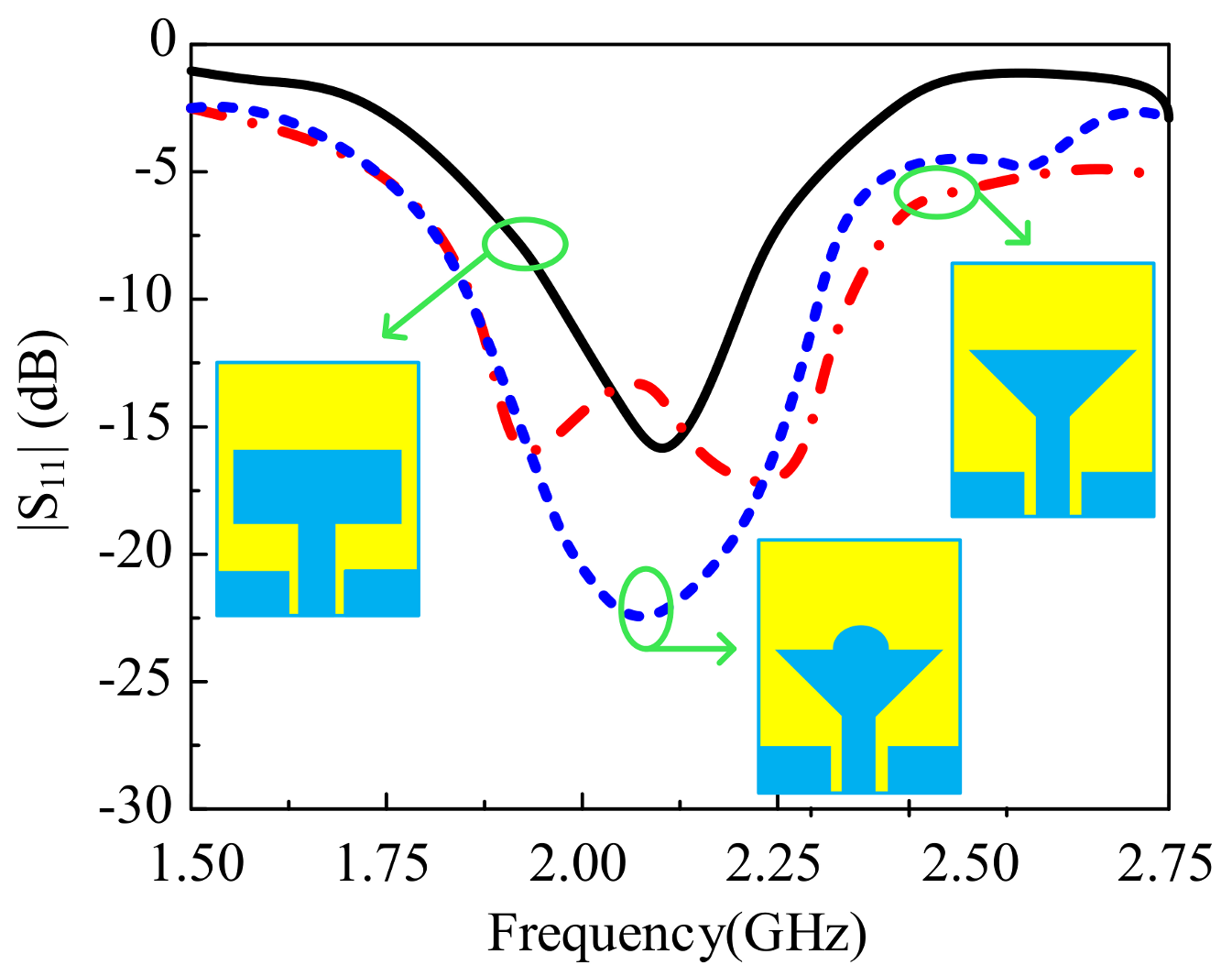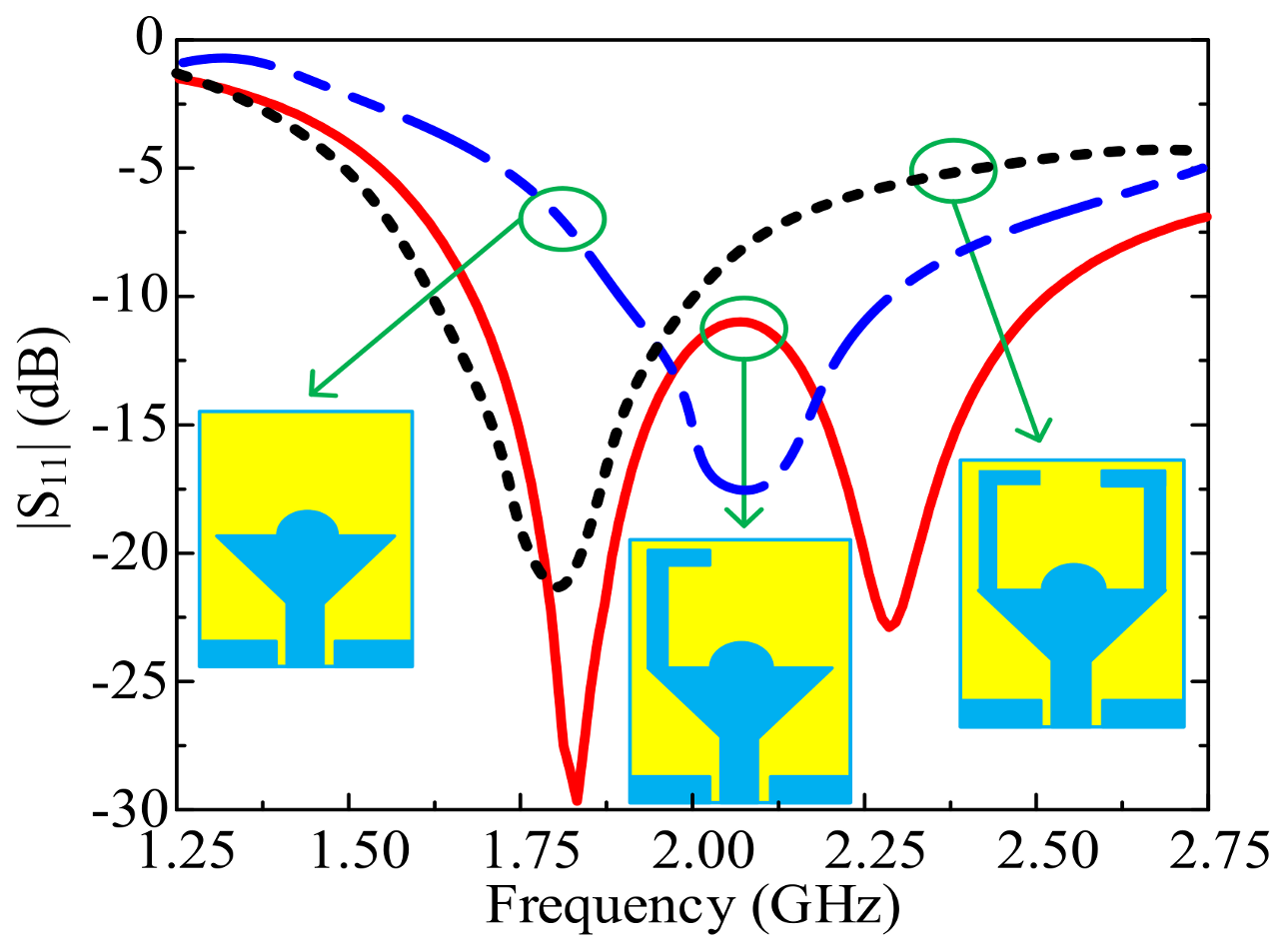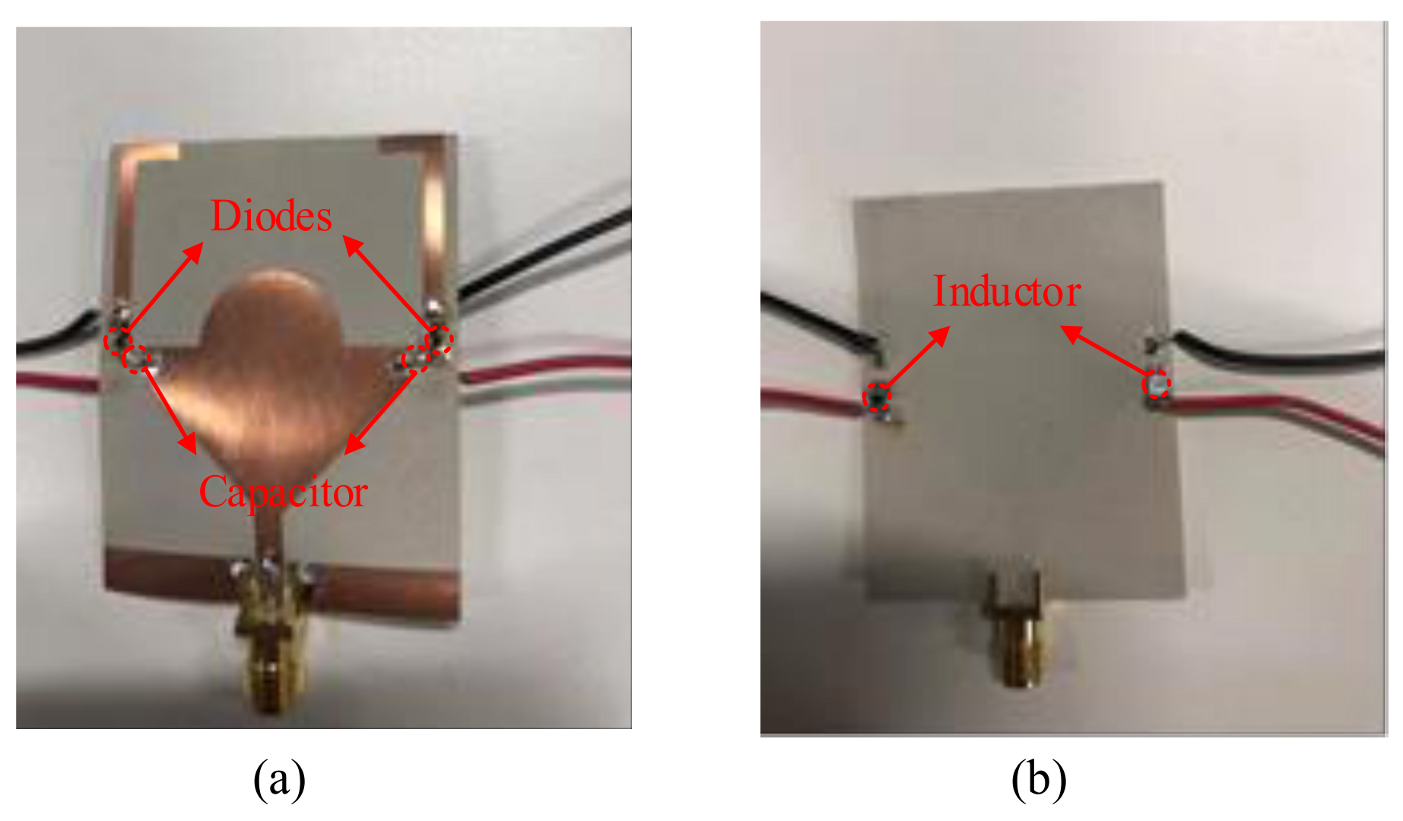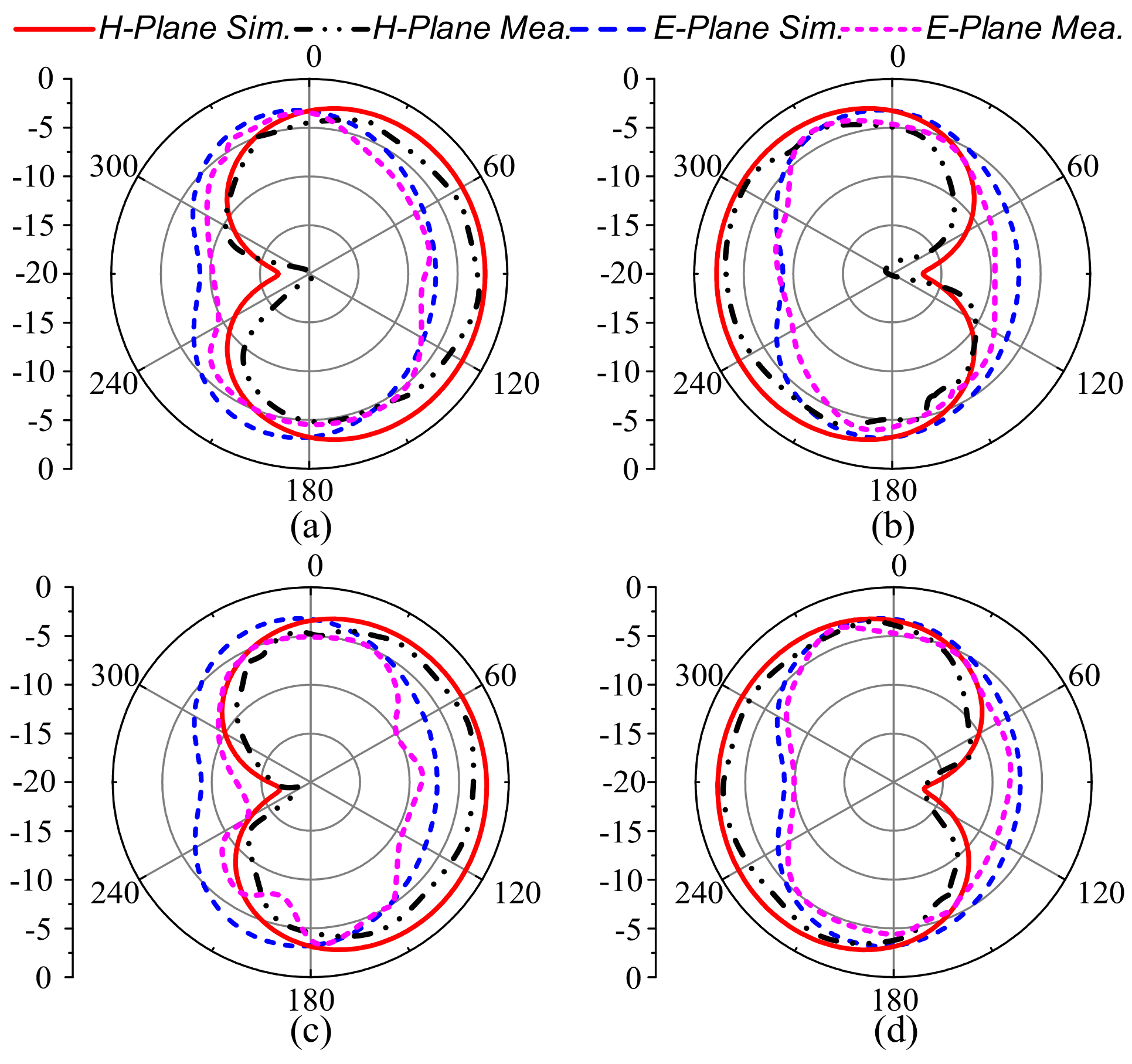A Flexible and Pattern Reconfigurable Antenna with Small Dimensions and Simple Layout for Wireless Communication Systems Operating over 1.65–2.51 GHz
Abstract
:1. Introduction
- A relatively compact and simple structured antenna is designed for frequency and pattern reconfigurability at the same time.
- The antenna utilizes only two pin diodes to switch between two narrow bands and a wideband along with pattern reconfigurability from omnidirectional to the directional pattern.
- The antenna offers good performance in both conformal and non-conformal conditions along with a good agreement between simulated and measured results.
- Comparison with state of the artwork states that the presented antenna overperforms the related works by providing an overall better performance, as depicted in Table 1.
2. Antenna Geometry and Design Methodology
2.1. Design of the Compact Flexible Monopole Antenna
2.2. Design of the Compound Reconfigurable Antenna
3. Results and Discussion
3.1. Reflection Coefficient
3.2. Conformability Analysis
3.3. Near-Field Analysis of Conformal and Non-Conformable Antenna
3.4. Gain and Radiation Efficiency
3.5. Comparison with State-of-the-Art Works
4. Conclusions
Author Contributions
Funding
Data Availability Statement
Conflicts of Interest
References
- Le, T.T.; Park, H.-Y.; Yun, T.-Y. Simple Reconfigurable Circularly Polarized Antenna at Three Bands. Sensors 2019, 19, 2316. [Google Scholar] [CrossRef] [Green Version]
- Naqvi, A.H.; Lim, S. Microfluidically polarization-switchable metasurfaced antenna. IEEE Antennas Wirel. Propag. Lett. 2018, 17, 2255–2259. [Google Scholar] [CrossRef]
- Awan, W.A. A Miniaturized Wideband and Multi-band On-Demand Reconfigurable Antenna for Compact and Portable Devices. AEU-Int. J. Electron. Commun. 2020, 2020, 153266. [Google Scholar] [CrossRef]
- Parchin, N.O.; Basherlou, H.J.; Al-Yasir, Y.I.; Abd-Alhameed, R.A.; Abdulkhaleq, A.M.; Noras, J.M. Recent developments of reconfigurable antennas for current and future wireless communication systems. Electronics 2019, 8, 128. [Google Scholar]
- Li, K.; Shao, Z.H.; Wang, Q.; Cheng, Y.J. Frequency-and pattern-reconfigurable antenna for multistandard wireless applications. IEEE Antennas Wirel. Propag. Lett. 2014, 14, 333–336. [Google Scholar] [CrossRef]
- Liu, J.; Li, J.; Xu, R. Design of very simple frequency and polarisation reconfigurable antenna with finite ground structure. Electron. Lett. 2018, 54, 187–188. [Google Scholar] [CrossRef]
- Lin, W.; Wong, H.; Ziolkowski, R.W. Circularly polarized antenna with reconfigurable broadside and conical beams facilitated by a mode switchable feed network. IEEE Trans. Antennas Propag. 2017, 66, 996–1001. [Google Scholar] [CrossRef] [Green Version]
- Mohamadzade, B.; Simorangkir, R.B.; Maric, S.; Lalbakhsh, A.; Esselle, K.; Hashmi, R.M. Recent Developments and State of the Art in Flexible and Conformal Reconfigurable Antennas. Electronics 2020, 9, 1375. [Google Scholar] [CrossRef]
- He, X.; Gao, P.; Zhu, Z.; You, S.; Wang, P. A flexible pattern reconfigurable antenna for WLAN wireless systems. J. Electromagn. Waves Appl. 2019, 33, 782–793. [Google Scholar] [CrossRef]
- Tang, M.-C.; Zhou, B.; Duan, Y.; Chen, X.; Ziolkowski, R.W. Pattern-reconfigurable, flexible, wideband, directive, electrically small near-field resonant parasitic antenna. IEEE Trans. Antennas Propag. 2018, 66, 2271–2280. [Google Scholar] [CrossRef]
- Chen, S.L.; Qin, P.Y.; Lin, W.; Guo, Y.J. Pattern-reconfigurable antenna with five switchable beams in elevation plane. IEEE Antennas Wirel. Propag. Lett. 2018, 17, 454–457. [Google Scholar] [CrossRef] [Green Version]
- Hussain, N. A Compact Flexible Frequency Reconfigurable Antenna for Heterogeneous Applications. IEEE Access 2020, 8, 173298–173307. [Google Scholar] [CrossRef]
- Saraswat, K.; Harish, A.R. Flexible dual-band dual-polarised CPW-fed monopole antenna with discrete-frequency reconfigurability. IET Microw. Antennas Propag. 2019, 13, 2053–2060. [Google Scholar] [CrossRef]
- Yang, S.; Vaseem, M.; Shamim, A. Fully Inkjet-Printed VO2-Based Radio-Frequency Switches for Flexible Reconfigurable Components. Adv. Mater. Technol. 2019, 4, 1800276. [Google Scholar] [CrossRef] [Green Version]
- Sreelakshmi, K.; Rao, G.S.; Kumar, M.N.V.S.S. A Compact Grounded Asymmetric Coplanar Strip-Fed Flexible Multiband Reconfigurable Antenna for Wireless Applications. IEEE Access 2020, 8, 194497–194507. [Google Scholar] [CrossRef]
- Saeed, S.M.; Balanis, C.A.; Birtcher, C.R. Inkjet-printed flexible reconfigurable antenna for conformal WLAN/WiMAX wireless devices. IEEE Antennas Wirel. Propag. Lett. 2016, 15, 1979–1982. [Google Scholar] [CrossRef]
- Saeed, S.M.; Balanis, C.A.; Birtcher, C.R.; Durgun, A.C.; Shaman, H.N. Wearable flexible reconfigurable antenna integrated with artificial magnetic conductor. IEEE Antennas Wirel. Propag. Lett. 2017, 16, 2396–2399. [Google Scholar] [CrossRef]
- Raman, S.; Mohanan, P.; Timmons, N.; Morrison, J. Microstrip-fed pattern-and polarization-reconfigurable compact truncated monopole antenna. IEEE Antennas Wirel. Propag. Lett. 2013, 12, 710–713. [Google Scholar] [CrossRef]
- Row, J.S.; Kuo, L.K. Pattern-Reconfigurable Array Based on a Circularly Polarized Antenna with Broadband Operation and High Front-to-Back Ratio. IEEE Trans. Antennas Propag. 2019, 68, 4109–4113. [Google Scholar] [CrossRef]
- Ji, L.Y.; Guo, Y.J.; Qin, P.Y.; Gong, S.X.; Mittra, R. A reconfigurable partially reflective surface (PRS) antenna for beam steering. IEEE Trans. Antennas Propag. 2015, 63, 2387–2395. [Google Scholar] [CrossRef]
- Nguyen-Trong, N.; Hall, L.; Fumeaux, C. A frequency-and pattern-reconfigurable center-shorted microstrip antenna. IEEE Antennas Wirel. Propag. Lett. 2016, 15, 1955–1958. [Google Scholar] [CrossRef]
- Selvam, Y.P.; Kanagasabai, M.; Alsath, M.G.; Velan, S.; Kingsly, S.; Subbaraj, S.; Rao, Y.R.; Srinivasan, R.; Varadhan, A.K.; Karuppiah, M. A low-profile frequency-and pattern-reconfigurable antenna. IEEE Antennas Wirel. Propag. Lett. 2017, 16, 3047–3050. [Google Scholar] [CrossRef]
- Zainarry, S.N.M.; Nguyen-Trong, N.; Fumeaux, C. A frequency-and pattern-reconfigurable two-element array antenna. IEEE Antennas Wirel. Propag. Lett. 2018, 17, 617–620. [Google Scholar] [CrossRef]
- Iqbal, A.; Smida, A.; Mallat, N.K.; Ghayoula, R.; Elfergani, I.; Rodriguez, J.; Kim, S. Frequency and pattern reconfigurable antenna for emerging wireless communication systems. Electronics 2019, 8, 407. [Google Scholar] [CrossRef] [Green Version]
- Shereen, M.K.; Khattak, M.I.; Al-Hasan, M.A. A Frequency and Radiation Pattern Combo-Reconfigurable Novel Antenna for 5G Applications and Beyond. Electronics 2020, 9, 1372. [Google Scholar] [CrossRef]
- Zhu, Z.; Wang, P.; You, S.; Gao, P. A flexible frequency and pattern reconfigurable antenna for wireless systems. Prog. Electromagn. Res. 2018, 76, 63–70. [Google Scholar] [CrossRef]
- Ghaffar, A.; Li, X.J.; Hussain, N.; Awan, W.A. Flexible Frequency and Radiation Pattern Reconfigurable Antenna for Multi-Band Applications. In Proceedings of the 4th IEEE Australian Microwave Symposium (AMS), Sydney, Australia, 13–14 February 2020; pp. 1–2. [Google Scholar]
- Balanis, C.A. Antenna Theory: Analysis and Design; John Wiley & Sons: Hoboken, NJ, USA, 2016. [Google Scholar]
- Abbas, A. A rectangular notch-band UWB antenna with controllable notched bandwidth and centre frequency. Sensors 2020, 20, 777. [Google Scholar] [CrossRef] [Green Version]













| Reference | Antenna Size (mm2) | Reconfigurable Type | Material Type | RF Switch Type | Frequency (GHz) |
|---|---|---|---|---|---|
| [9] | 35 × 25 | Radiation Pattern | Flexible | Discrete | 2.4–2.48 |
| [13] | 50 × 33 | Frequency | Flexible | Discrete | 2.18–2.3.58 |
| [15] | 24 × 19 | Frequency | Flexible | Discrete | 2.4/3.8/5.6 |
| [16] | 59 × 31 | Polarization and Frequency | Flexible | Discrete | 2.36/3.64 |
| [17] | 89 × 83 | Polarization and Frequency | Flexible | Discrete | 2.45/3.3 |
| [21] | 85 × 85 | Radiation Pattern and Frequency | Solid | Continuous | 2.68–3.51 |
| [22] | 50 × 50 | Frequency and Radiation Pattern | Solid | Discrete | 4.5/4.8/5.2/5.8 |
| [23] | 151.5 × 160.9 | Frequency and Radiation Pattern | Solid | Continuous | 2.15–2.38 |
| [24] | 23 × 31 | Frequency and Radiation Pattern | Solid | Discrete | 3.1–6.8 |
| [25] | 112 × 52 | Frequency and Radiation Pattern | Solid | 18 NMOS transistor | 28/38 |
| This work | 40 × 50 | Frequency and Radiation Pattern | Flexible | Discrete | 1.65–2.51 |
Publisher’s Note: MDPI stays neutral with regard to jurisdictional claims in published maps and institutional affiliations. |
© 2021 by the authors. Licensee MDPI, Basel, Switzerland. This article is an open access article distributed under the terms and conditions of the Creative Commons Attribution (CC BY) license (http://creativecommons.org/licenses/by/4.0/).
Share and Cite
Ghaffar, A.; Li, X.J.; Awan, W.A.; Naqvi, A.H.; Hussain, N.; Alibakhshikenari, M.; Limiti, E. A Flexible and Pattern Reconfigurable Antenna with Small Dimensions and Simple Layout for Wireless Communication Systems Operating over 1.65–2.51 GHz. Electronics 2021, 10, 601. https://doi.org/10.3390/electronics10050601
Ghaffar A, Li XJ, Awan WA, Naqvi AH, Hussain N, Alibakhshikenari M, Limiti E. A Flexible and Pattern Reconfigurable Antenna with Small Dimensions and Simple Layout for Wireless Communication Systems Operating over 1.65–2.51 GHz. Electronics. 2021; 10(5):601. https://doi.org/10.3390/electronics10050601
Chicago/Turabian StyleGhaffar, Adnan, Xue Jun Li, Wahaj Abbas Awan, Aqeel Hussain Naqvi, Niamat Hussain, Mohammad Alibakhshikenari, and Ernesto Limiti. 2021. "A Flexible and Pattern Reconfigurable Antenna with Small Dimensions and Simple Layout for Wireless Communication Systems Operating over 1.65–2.51 GHz" Electronics 10, no. 5: 601. https://doi.org/10.3390/electronics10050601
APA StyleGhaffar, A., Li, X. J., Awan, W. A., Naqvi, A. H., Hussain, N., Alibakhshikenari, M., & Limiti, E. (2021). A Flexible and Pattern Reconfigurable Antenna with Small Dimensions and Simple Layout for Wireless Communication Systems Operating over 1.65–2.51 GHz. Electronics, 10(5), 601. https://doi.org/10.3390/electronics10050601












